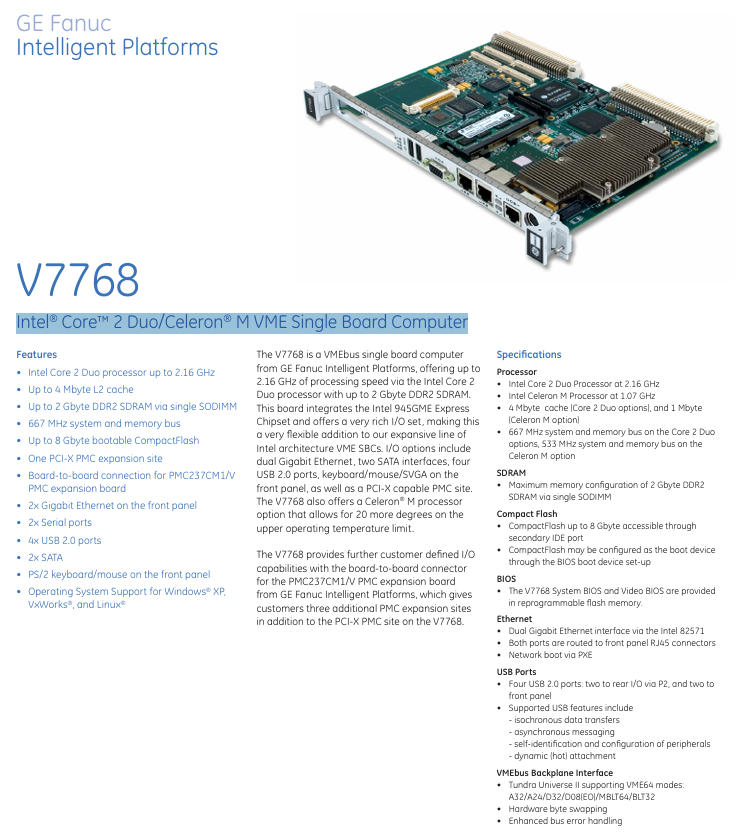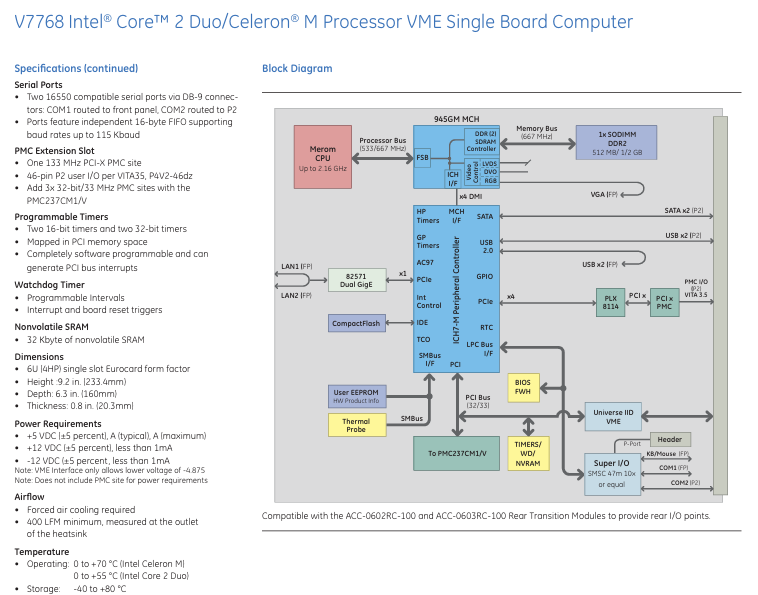Core positioning and advantages of the product
V7768 is a VME bus single board computer based on Intel architecture, featuring high flexibility and rich I/O expansion capabilities, suitable for industrial scenarios that require stable embedded computing. Its core advantages include:
Supports Intel Core 2 Duo/Celeron M processors, adapting to different performance and temperature requirements;
Integrate multiple types of interfaces (dual Gigabit Ethernet, SATA, USB, etc.) to meet basic connectivity requirements without the need for additional expansion;
Provide PCI-X PMC expansion slots and board to board connectors, which can further expand up to 3 PMC sites and adapt to complex I/O scenarios;
Compatible with mainstream operating systems such as Windows XP, VxWorks, Linux, and adaptable to various software environments.

Hardware configuration and performance parameters
1. Processor and Storage
Category specific configuration
Processor – Intel Core 2 Duo: up to 2.16GHz, 4MB L2 cache, 667MHz system/memory bus
-Intel Celeron M: 1.07GHz, 1MB L2 cache, 533MHz system/memory bus
Maximum 2GB DDR2 SDRAM memory (expandable through a single SODIMM slot)
Storage expansion supports up to 8GB CompactFlash (accessible through a secondary IDE port and configurable as a BIOS boot device)
Non volatile storage 32KB non-volatile SRAM (used to store critical data)
2. Interface and Expansion Capability
The V7768 interface covers scenarios such as network, storage, peripherals, and bus expansion, as follows:
Network interface: Dual Gigabit Ethernet (based on Intel 82571 chip), both connected through RJ45 connectors on the front panel, supporting PCIe network boot;
Storage interface: 2 SATA interfaces (leading to the rear P2 interface), used for connecting hard drives/SSDs;
USB interface: 4 USB 2.0 ports (2 front panel, 2 rear P2 ports), supporting synchronous data transfer, automatic peripheral recognition, and hot plugging;
Serial interface: 2 16550 compatible serial ports (DB-9 connector), COM1 front, COM2 rear, supporting up to 115K baud rate, including 16 byte FIFO;
Human computer interaction interface: The front panel integrates PS/2 keyboard/mouse interface and SVGA display interface;
Bus and Expansion:
VME bus: supports VME64 mode (A32/A24/D32/D08 (EO)/MBLT64/BLT32), including hardware byte swapping and enhanced bus error handling;
PMC Expansion: 1 133MHz PCI-X PMC slot, supporting VITA35 standard; By pairing the board to board connector with the PMC237CM1/V expansion board, an additional 3 32-bit/33MHz PMC stations can be added.
3. Timer and monitoring function
Programmable timers: 2 16 bit timers+2 32-bit timers, mapped to PCI memory space, supporting software programming and PCI bus interrupts;
Watchdog timer: configurable time interval, supports interrupt triggering and board level reset, improves system stability;
BIOS: The system BIOS and video BIOS are stored in programmable flash memory and support device configuration during startup.
Physical and environmental parameters
1. Physical specifications
Appearance: 6U (4HP) single slot Eurocard standard size;
Dimensions: Height 9.2 inches (233.4mm), Depth 6.3 inches (160mm), Thickness 0.8 inches (20.3mm);
Rear transition module compatibility: Supports ACC-0602RC-100 and ACC-0603RC-100 for expanding rear I/O.
2. Power requirements
+5VDC (± 5%): Typical value not labeled, maximum value not labeled (note: excluding PMC expansion slot power consumption);
+12VDC (± 5%): current<1mA;
-12VDC (± 5%): Current<1mA (VME interface allows minimum voltage -4.875V).
3. Environmental adaptability
Environmental indicator requirements
Working temperature Intel Celeron M version: 0~+70 ℃; Intel Core 2 Duo version: 0~+55 ℃
Storage temperature -40~+80 ℃
Working altitude: 0-10000 feet (3000 meters)
Storage altitude: 0-40000 feet (12000 meters)
Humidity operation/storage: 5%~95% relative humidity (non condensing)
Mandatory air cooling is required for heat dissipation, with a minimum wind speed of 400 LFM (linear feet per minute) at the outlet of the radiator
Mean Time Between Failures (MTBF) requires contacting the manufacturer for specific data



Leave a comment
Your email address will not be published. Required fields are marked *